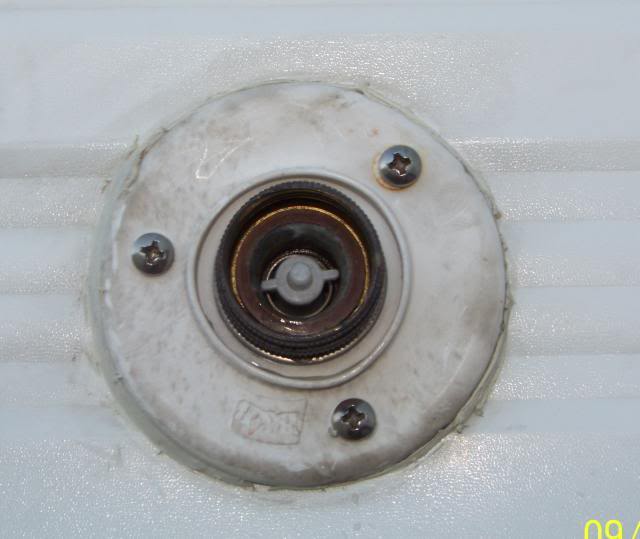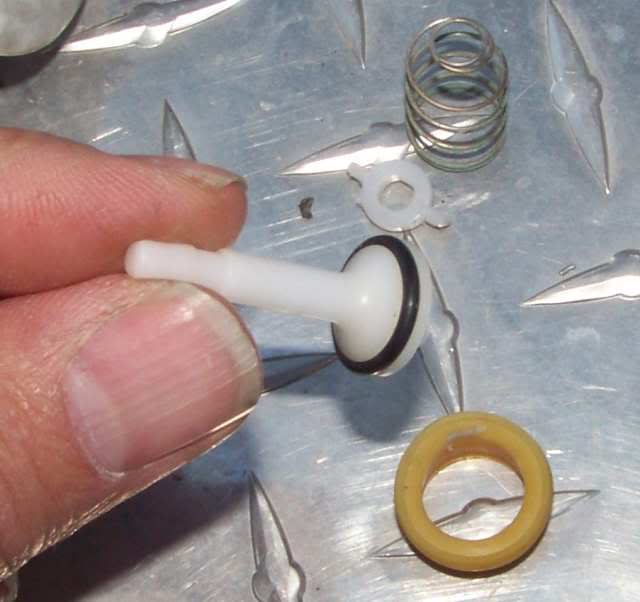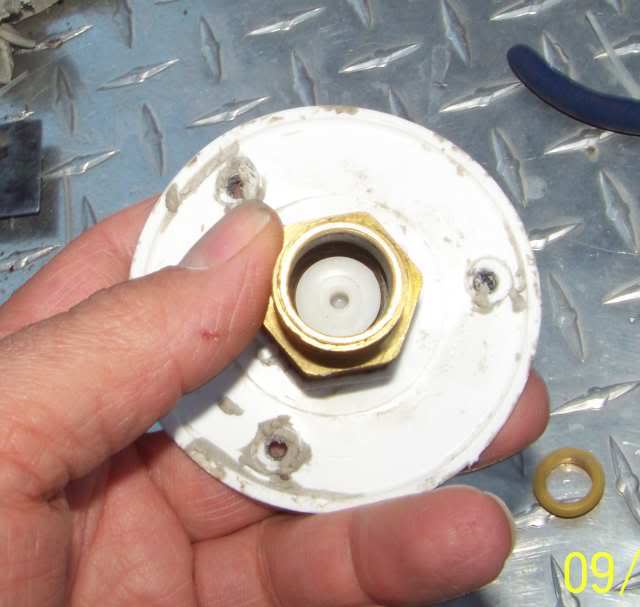 |
 11-03-2011, 12:24 PM
11-03-2011, 12:24 PM
|
#1
|
|
Senior Member
Join Date: Aug 2010
Location: Virginia
Posts: 210
SUN #1340
|
Winterizing: a learning experience
Winterized the trailer last week...it's hard to believe another summer has come and gone. Here in VA the leaves may already be past their peak, but are still beautiful to behold.
I hate to admit to stupidity, but like to help others from making the same mistakes I have made. So, it's revelation time.
I use the dry winterizing method, and then add antifreeze to the drains. I wish I had known last year about the little drain valve inside the city water hook up hose connection. Last year, I blew all the water that this year I released through that little valve, back through the system, and it took me forever to drain the system. This year, I found that little bugger, and after holding my pinkie on the valve and draining about a half gallon or so of water from the system, it took me about half the time to blow the remaining water out of the system that it took last year. In all the winterizing info I have read, and that's a lot, only one "how to" mentioned that little hidden valve. All of the winterizing info I've read also mentions opening the "low point drain valve" during the winterizing process, and talks about what a pain it can be to find that valve. Well, on my 88 Seville, Sunline did an excellent job of hiding that bad boy, because I have yet to find it! I dunno...is that valve inside the hose connector the low point drain valve?????
I also followed the advice of one of the winterizing posts and siphoned out the water heater tank after I had unscrewed the plug and it had stopped draining. I was amazed at the amount of water I got out of the tank! There was over a quart left after the water had stopped dripping out of the drain plug hole. A note here: You need to be persistent in siphoning this remaining water out of the tank because you can't see what you are doing. You need to blow into the siphon hose until you hear water bubbling and then give it a suck and drain out what you can. Keep doing this until you don't hear water bubbling when you blow on the siphon hose. I used a small 3/8" or 1/4" (opening) siphon hose.
Here's wishing all of you good and helpful folks a safe, happy and joyful winter.
Drake
__________________
__________________
 '88 T3200
Permanently situated in Charlotte County VA
|

|

|
 11-03-2011, 02:18 PM
11-03-2011, 02:18 PM
|
#2
|
|
Moderator Emeritus
Join Date: Jul 2009
Location: South Carolina
Posts: 2,040
SUN #897
|
Quote:
Originally Posted by Drake

All of the winterizing info I've read also mentions opening the "low point drain valve" during the winterizing process, and talks about what a pain it can be to find that valve. Well, on my 88 Seville, Sunline did an excellent job of hiding that bad boy, because I have yet to find it! I dunno...is that valve inside the hose connector the low point drain valve?????
|
Hey Drake,
If you have trouble finding the low point drains, you can do what I did.. I looked under our Sunny and found the two pieces of PEX, that were pointing toward the ground. Perhaps all you will see, are the open ends of those pipes. If you go in the camper, you will find the valves directly above where they came out the bottom.
Gary
__________________
|

|

|
 11-03-2011, 03:03 PM
11-03-2011, 03:03 PM
|
#3
|
|
Senior Member
Join Date: Apr 2007
Location: New York
Posts: 1,846
SUN #264
|
Quote:
Originally Posted by Drake

I dunno...is that valve inside the hose connector the low point drain valve?????
|
Drake, that valve in the garden hose connection for city water is a check valve to keep water from backflowing out of the trailer when the 12vdc pump applies pressure to the system.
When you winterize by pumping antifreeze throughout the system, you should stand off to one side, and work that valve by pressing it in very briefly a couple of times until pink flows just like your faucets and toilet.
Beware, if the other faucets are closed and the pump has run the system back up to full pressure, when you push the little thingy, it is gonna shoot out of there a lot more than you might think!! Stand well off to the side, or wear your stormy weather gear! 
When you dewinterize in the spring, you can either do the same with fresh water via the pump, or just hook up your garden hose and push the antifreeze out that way.
__________________

'12 F250 4x4 Super Duty PowerStroke 6.7 diesel
2011 to present: '11 Cougar 326MKS
1999 to 2011: '99 Sunline T-2453
SUN264 * Amateur Radio kd2iat monitoring 146.52
|

|

|
 11-03-2011, 07:40 PM
11-03-2011, 07:40 PM
|
#4
|
|
Senior Member
Join Date: Aug 2010
Location: Virginia
Posts: 210
SUN #1340
|
EMD and Steve, thanks for the feedback! EMD, I think I now know where to look for those valves... have a couple of white hoses that have insulating foam around them set together in a clump under the trailer close to the kitchen sink area. So Steve, since I dry winterize, I am doing the right thing by just draining that back pressure valve, correct? Steve, do you have a winterizing tip sheet on this website? If so, could you include info on these little details in the instructions? I, and I think lots of others would be VERY grateful!
__________________
 '88 T3200
Permanently situated in Charlotte County VA
|

|

|
 11-03-2011, 08:37 PM
11-03-2011, 08:37 PM
|
#5
|
|
Senior Member
Join Date: Apr 2007
Location: New York
Posts: 1,846
SUN #264
|
If you dry winterize, you should get one of those air adapters that screws onto the city water inlet. It lets you hook up a compressor and blow the entire water system dry.
Simply pressing in the check valve and draining a little bit of water won't accomplish what needs to be done for winterizing.
There are instructions on winterizing in the files area, I believe. I did not write them, however.
__________________

'12 F250 4x4 Super Duty PowerStroke 6.7 diesel
2011 to present: '11 Cougar 326MKS
1999 to 2011: '99 Sunline T-2453
SUN264 * Amateur Radio kd2iat monitoring 146.52
|

|

|
 11-03-2011, 08:44 PM
11-03-2011, 08:44 PM
|
#6
|
|
Moderator
Join Date: Nov 2006
Location: Ohio
Posts: 12,656
SUN #89
|
Hi Drake
Following your wording it does sound like you where pressing in the inlet check valve on the city water connection.
Does it look like this vintage?

If it does I'll express caution on that little bugger....  I do not know if all the inlet checks are made the way mine are, but if it matches this 2004 vintage all I can do is caution you not to press it in and attempt to blow water backwards out the city water inlet. Or to burp it under pressure to cause a back flow.
Blow "in" is fine, it is the back wards that creates the havoc if that was what you where doing. And pressing it in to create a drain vent is fine. It is just the back flow under pressure that is the concern.
On my vintage.... I did this twice... dumb me I forgot after the 1st time it happened years ago...  so I did it again. Well it is now safely burnt into the memory cell, don't do that....
On mine there is the O ring that creates the seal.

And when the normal pressure pushed backwards it seats that O ring against the valve body inside the valve. Like this

All works well until.... I pressed the plunger in when the system was has much pressure in it. Does not even have to be full pressure. Oh yes water fly's out and in doing so the way mine is designed it blows the O ring right off that stem. There is no grove large enough to hold the back flow and the pressure flow unseats that O ring. It scan stop the water from coming out OK as there is no flow then.
And when the O ring comes off, the valve will never seat right and water leaks out the city water inlet and won't stop. I also now carry a plug I can screw in there if this thing ever starts weeping when I'm out camping and don't want to fuss with it. We run on on board tanks most of the time so that check has to work.
Well once I was lucky. I could fish that O ring back on without having to take the valve out of the camper. And as you can tell from those pics I was not so lucky the 2nd time. Had to take the entire valve out of the camper, figure out how to take it apart and put the O ring back on. Then re-butyl tape it and put it all back on the camper.
If anyone wants to see how all the pieced fit, see these pics.
Fresh Water Inlet Valve pictures by JBarca - Photobucket
Again your older one may be made different and so may others. But the ones used in the 2004 Sunlines.... heads up!
Hope this helps
John
__________________
Current Sunlines: 2004 T310SR, 2004 T1950, 2004 T2475, 2007 T2499, 2004 T317SR
Prior Sunlines: 2004 T2499 - Fern Blue
2005 Ford F350 Lariat, 6.8L V10 W/ 4.10 rear axle, CC, Short Bed, SRW. Reese HP trunnion bar hitch W/ HP DC
 Google Custom Search For Sunline Owners Club
Google Custom Search For Sunline Owners Club
|

|

|
 11-03-2011, 09:24 PM
11-03-2011, 09:24 PM
|
#7
|
|
Senior Member
Join Date: Aug 2010
Location: Virginia
Posts: 210
SUN #1340
|
Right....good information as ALWAYS from you guys!!! Yes John...it does look to be "that vintage." And thanks for the tip re not blowing backwards against this valve via the onboard pump. I don't use my fresh water tank...strictly city water, so pressure from the onboard pump is not an issue. I am glad you included this info for others who do use the fresh water tank and pump though.
Steve, yes, I know I still have to blow out the lines after I drain from this valve, but holy smokes, what a difference in water volume to be blown out after draining at this valve. Yes, I have a blowout plug, one with an automotive tire valve stem, and a clip on the "peanut" attachment for my air compressor hose which allows me to hook up to the valve and winterize without help from the inside of the trailer if necessary, though winterizing is best done as a team, I find.
__________________
 '88 T3200
Permanently situated in Charlotte County VA
|

|

|
 11-06-2011, 06:00 AM
11-06-2011, 06:00 AM
|
#8
|
|
Senior Member
Join Date: Sep 2011
Location: Connecticut
Posts: 373
SUN #2943
|
Thanks John for the pics, I just did the same (broke it, not fixed it yet). I'll look at it today once it warms up. Luckally I had a male hose plug handy so I could pressurize the system to finish winterizing.
__________________
|

|

|
 11-06-2011, 11:21 AM
11-06-2011, 11:21 AM
|
#9
|
|
Senior Member
Join Date: Sep 2011
Location: Connecticut
Posts: 373
SUN #2943
|
Mine is a 2007 and had the exact setup. I pulled it apart today, reset the o-ring re-butyled and reinstalled. Only hitch was I only had black butyl tape in a good size.
Again, thanks for the timely discussion.
__________________
|

|

|
 11-14-2011, 07:52 AM
11-14-2011, 07:52 AM
|
#10
|
|
Senior Member
Join Date: Apr 2007
Location: Missouri
Posts: 251
SUN #254
|
I know I posted my "dumb thing" here last year but here it is again. If you have left over antifreeze (the pink stuff) and also have power washer soap solution (also pink stuff) be sure you know which is which. The label came off my soap jug and it was stored on the same garage shelf with the antifreeze. You can guess what happened.
__________________
Paul & Jan
Columbia, Missouri
2014 Cougar 31RKS, 2012 blue Oval F 250 XLT 6.2 L, 6 speed, 4 X 4.
www.62ford.com/registry

|

|

|
 11-14-2011, 10:25 AM
11-14-2011, 10:25 AM
|
#11
|
|
Senior Member
Join Date: Aug 2006
Location: Maryland
Posts: 838
SUN #37
|
I'm in the process of winterizing now and have always followed the printed instructions I got somewhere online that say I should blow out the water hoses with compressed air and then add the anti freeze. Is this overkill? I'm in western Maryland where the temps can dip below zero, but only for a few days at most.
Also, whether the antifreeze is used after blowing air through the system or not, is there anything that should be done to that city water valve to keep it from freezing?
Thanks,
Rich
__________________
 1992 T-2470 (now residing in South Carolina)
Current Sunline-2007 Solaris 2499
2018 Silverado 1500 w/Max Trailering pkg.
|

|

|
 11-14-2011, 02:19 PM
11-14-2011, 02:19 PM
|
#12
|
|
Senior Member
Join Date: May 2008
Location: Ontario
Posts: 663
SUN #597
|
I have not always had the short hose for connecting the ac to the city inlet... and this year I forgot to use it to boot! You should drain the lines via the low point drains, but it makes no difference in my experience--and that's Canadian winters--whether the lines are subsequently blown out. I also always have used just under 2 jugs of antifreeze whether the lines are blown out or not. I have never taken a chance on a "dry" winterizing although I have heard of people who carry a little air compressor with them to FL and then blow the lines out on the way home. But... by then it's spring.
I didn't always know how to safely burp the city check valve, or even that it could be done. So, no, there too. The reason you don't see instructions for burping this valve is, first, that it is totally unnecessary--antifreeze will diffuse into the small amount of water left in this line and protect it without any intervention--and second... if done incorrectly it can lead to major problems as the water pump will empty the fresh water tank through the broken check valve. If you choose to burp this valve, it should be the very last thing you do after opening all the taps to relieve all pressure. The force needed to push in the little button should be at most the force needed to work a retractable ball point pen. The small amount of water that runs out, followed by antifreeze, should convince you that the antifreeze will indeed diffuse into this water and protect this area without burping. All water taps, however, should always be left open as that will provide a small amount of pressure relief just in case something freezes and should prevent any damage. When we head south in the winter I always shut the water off in the house and open the taps too, which at the very least drains the upstairs lines in our 2-storey house.
Henry
__________________
__________________
2019 F150 3.5L Max Tow
2014 Arctic Fox 22G
2005 Sunline T-2499

|

|

|
 |
|
Currently Active Users Viewing This Thread: 1 (0 members and 1 guests)
|
|
|
 Posting Rules
Posting Rules
|
You may not post new threads
You may not post replies
You may not post attachments
You may not edit your posts
HTML code is Off
|
|
|
|
 » Recent Sunline Discussions
» Recent Sunline Discussions |
|
|
|
|
|
|
|
|
|
|
|
|
|
|
|
|
|
|
|
|
|
|
|
|
|
|
|
















 '88 T3200
'88 T3200 





 I do not know if all the inlet checks are made the way mine are, but if it matches this 2004 vintage all I can do is caution you not to press it in and attempt to blow water backwards out the city water inlet. Or to burp it under pressure to cause a back flow.
I do not know if all the inlet checks are made the way mine are, but if it matches this 2004 vintage all I can do is caution you not to press it in and attempt to blow water backwards out the city water inlet. Or to burp it under pressure to cause a back flow. 



 1992 T-2470 (now residing in South Carolina)
1992 T-2470 (now residing in South Carolina)
 Linear Mode
Linear Mode




